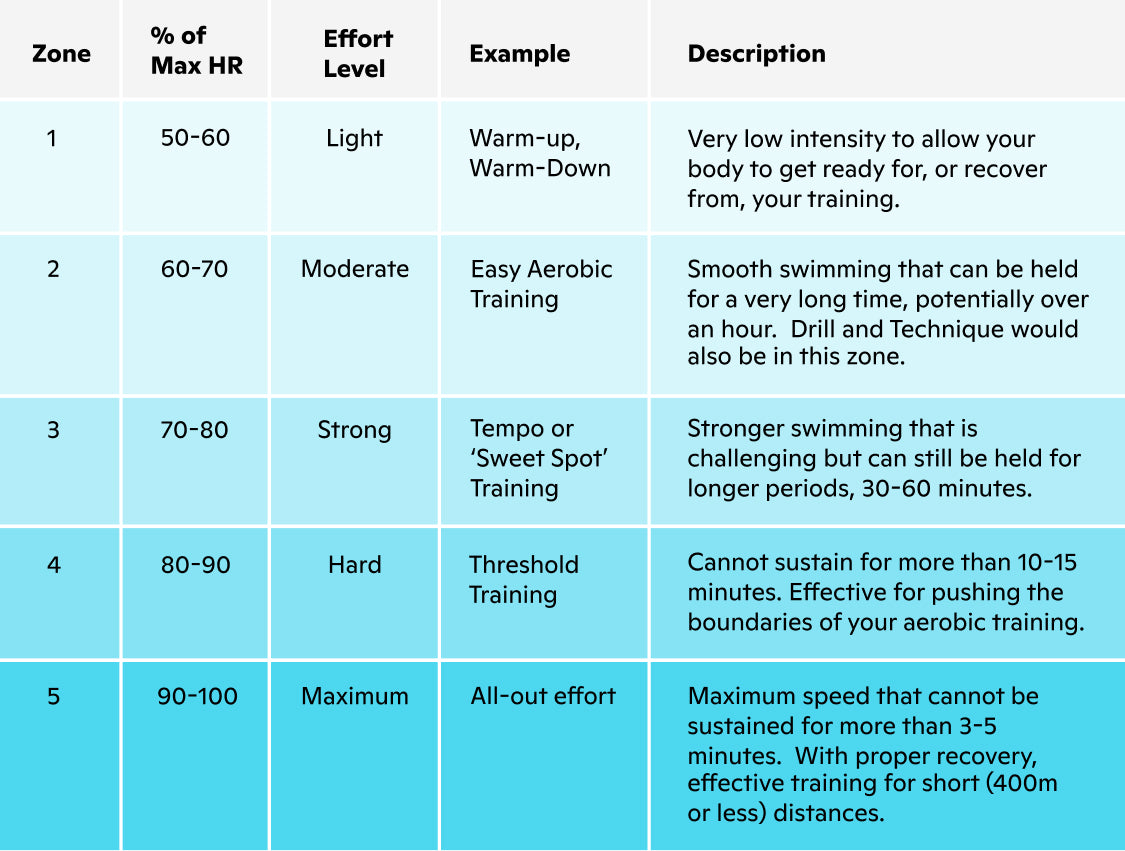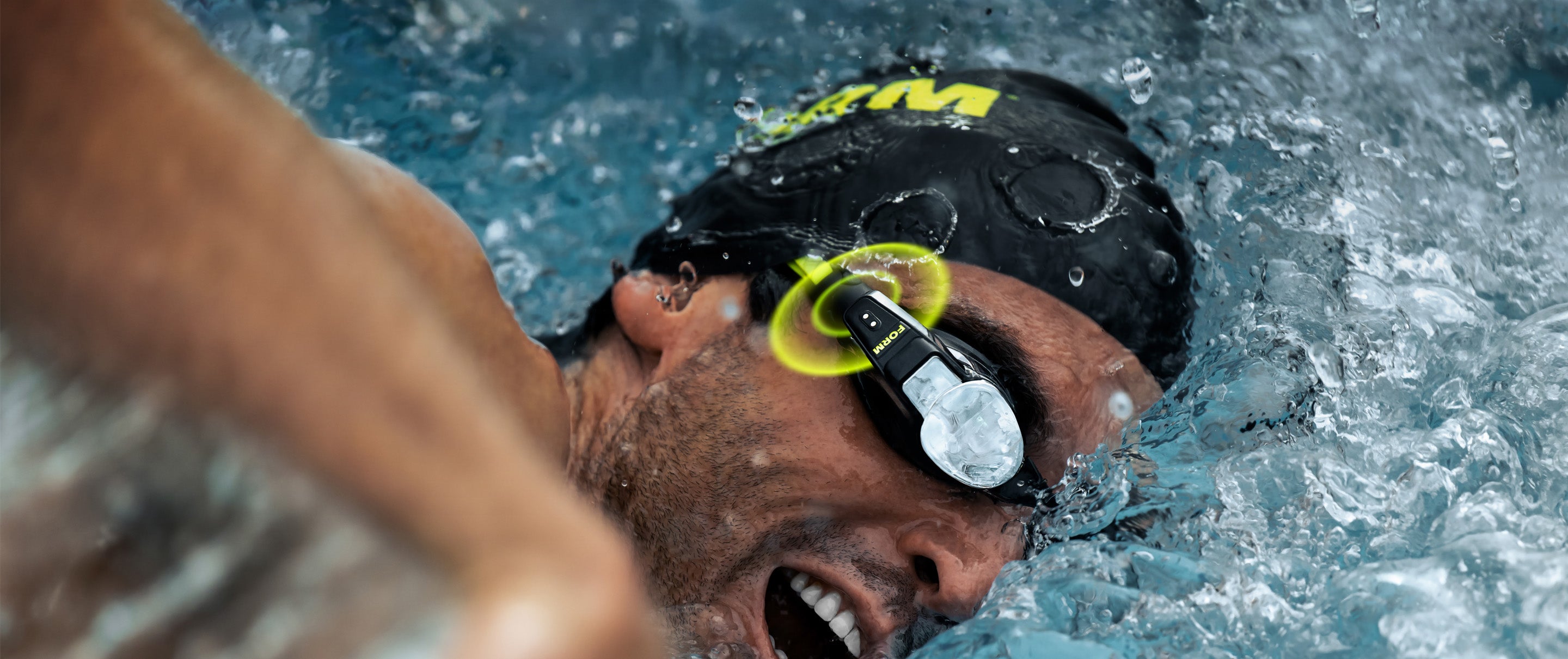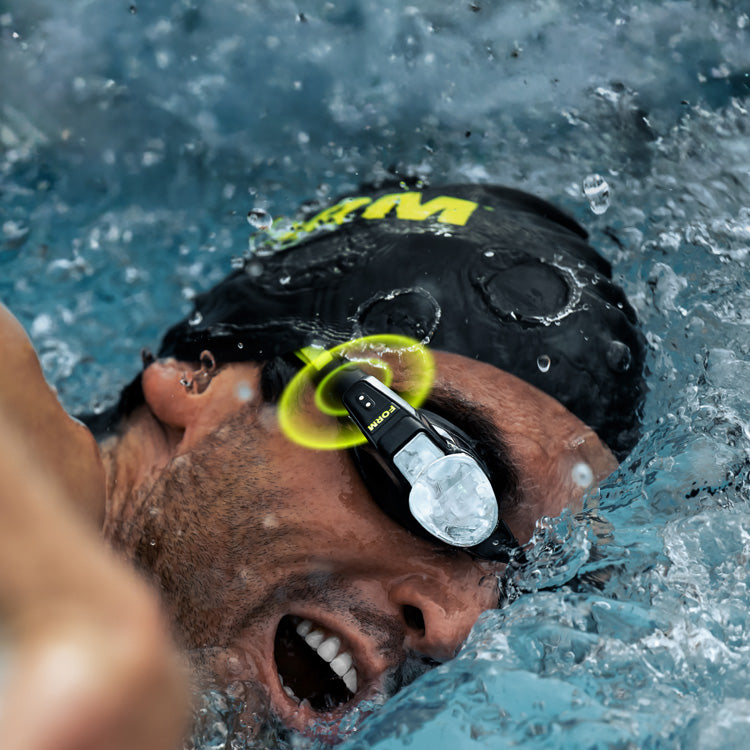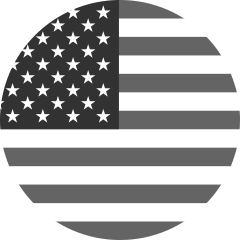Using Heart Rate Training Zones To Improve Your Swim Training
Whether you are trying to improve your endurance for a triathlon or get a faster 100m sprint, using Heart Rate training zones will help you personalize your training plan to improve your swimming. By monitoring your Heart Rate, you will be able to measure the intensity of your training and use your Heart Rate as guidance to ensure that you are training purposefully towards your goal.
In this article, we will gain a deeper understanding of Heart Rate Training Zones and how Heart Rate Training Zones for swimming can be used to optimize your workouts.
Heart Rate Training Zones
We will start with the foundational understanding of why athletes should use training zones to prepare for their events. Training Zones help define what intensity you should be training at in order to match your training to the physiological demands of the race you are preparing for. In addition, training zones help define how long you can train at a given intensity, and how much rest you need to recover.
As a starting point, the table below is an overview of how Heart Rate can be used to define your Training Zones and how they can be used for training:

Establishing your Heart Rate Training Zones requires you to know what your Max Heart Rate is. You can find more detail on how to get your Max Heart Rate, as well as the importance of monitoring your Heart Rate during you swim training, in our Guide to Setting Your Heart Rate Training Zones to Elevate Your Swim Training.
With that, let’s dive into each of these zones to better understand how to apply them to your training.
Zone 1: 50-60% of Max HR
The primary purpose of Zone 1 training is to get your body ready for more intense training using heart rate zones, or to recover from intense training that you just completed.
You do not want to arrive at the pool and go straight into your hardest work without any preparation. This can be dangerous and lead to injury, so starting with a warm-up swimming in Zone 1 is important to ensure that you are preparing for your workout in a safe way.
Sample Set:
3 x 100 Freestyle @ 30 Seconds Rest, placed at the start of a workout
Conversely, you do not want to leave the pool right at the end of a set where your heart rate is the highest. This can be dangerous and your body will not recover from your training properly to get the most helpful adaptation to your training. Using Zone 1 swimming as active recovery at the end of workout, or between high intensity intervals, will let your body recover and adapt between sessions more effectively.
Sample Set:
4 x 50 Freestyle @ 20 Seconds Rest, placed at the end of a workout
You can also use Zone 1 training in order to learn a new skill or adjust your technique before trying to apply it at higher intensities. When learning or adjusting your technique, it is best to focus solely on improving your stroke rather than the difficulty of your training using heart rate zones.
Sample Set working on improving your kick during your swimming:
4 x 25 Freestyle Kick with a Kickboard @ 20 Seconds Rest
4 x 25 Catch-up Drill Freestyle @ 20 Second Rest, holding a steady kick
4 x 25 Freestyle @ 20 Seconds Rest, holding a steady kick
Zone 2: 60-70% of Max HR
For the majority of swimmers, most of your training volume will be done in Zone 2 which is the foundation for training aerobically during your workouts. Traditional training plans have as much as 80% of the total volume swum in this zone, with more elite level endurance athletes swimming closer to 90% of their training in Zone 2. By establishing the base of your training in this zone, your body will:
- Make the greatest gains in cardiovascular endurance
- Increase your fatigue resistance for longer durations (such as for Ironman or 10km races)
- Recover better from intense training within and between workouts
While the physiological benefits of Zone 2 training are clear, it is important to remember that all training in this zone should be adjusted so that you can hold your technique the entire time. This can be particularly challenging for those that may be very fit out of the water but are new to swim training. Your cardiovascular fitness may be there, but the endurance for swimming specific muscle groups is not.
One way to check on your technique is to count your strokes during your intervals. Let’s say you try a set of 5 x 200 on 30 Seconds Rest, and on the first 200 you take 50 strokes for each 50-meter length. As you progress through the set, if your stroke count climbs up to 55 or 60, then it’s a sign you should adjust the set to 150’s instead so you can hold your stroke better. On the other hand, if you find that you can hold your stroke count at 50 throughout the set, you can take it as a sign that you are ready for longer intervals, increasing to 300’s or 400’s next time.
Using FORM Goggles, tracking your FORM Score length-by-length, along with your Heart Rate, will allow you to see how well you are holding your stroke technique while staying in the proper training zone.
Sample Sets with same distance/benefits with increasingly longer intervals depending on your ability to hold your technique
Short - 8 x 150 Freestyle @ 20 Seconds Rest
Medium - 6 x 200 Freestyle @ 30 Seconds Rest
Long - 3 x 400 Freestyle @ 40 Second Rest

Athlete: Lionel Sanders. Photo credit: Talbot Cox.
Zone 3: 70-80% of Max HR
When you swim, or do any exercise, at a low, steady pace for a long time, your heart rate will stay relatively stable. As you increase your intensity, your heart rate increases but will remain stable until you hit a point, around 80% of your max, where your heart rate starts to rise rapidly. This point is called your Heart Rate Threshold, and it marks the border between Zone 3 and Zone 4 training.
Zone 3 training is considered ‘sub-threshold’ training and is the highest training intensity before you cross your heart rate threshold. Some other terminology used for Zone 3 training is ‘Tempo’ or ‘Sweet’ Spot training and it is a very important zone when preparing for long distance events. This training zone will be close to the actual swimming pace for a triathlon especially for shorter ones such as an Olympic or Sprint.
Zone 3 training will help an athlete prepare for their race as it serves as a great way to replicate the challenges of the race in training. Building on the technique example from Zone 2 training, trying to hold your stroke count during Zone 3 training will give you an additional challenge to holding your stroke technique, while still getting the physiological benefits of nearly maxing out your aerobic training intensity.
While Zone 3 training is still beneficial, it can be deceptively hard on your body and requires more rest than you may realize. In fact, one hypothesized reason for overtraining in elite swimmers is because an overtrained swimmer is unintentionally doing too much training in Zone 3, even though they intend to be training in Zone 2. Remember that the majority of your training should be in Zone 2, so if you find that your heart rate is getting into Zone 3 when it should be in Zone 2, it is alright to dial back the intensity so that you can stay healthy and maximize the benefits of your training.
Set Example for a Sprint Triathlon
8 x 100 @ 30 SR, at or near your Triathlon Race Pace
Zone 4: 80-90% of Max HR
Zone 4 training is when your heart rate is at or above your Heart Rate threshold, and is commonly referred to as Threshold training. While the vast majority of your training should be done in Zone 2, the remainder of your training should mostly be done in Zone 4, especially in preparation for aerobically focused events. Zone 2 training provides the foundation of your training and will raise the ‘floor’ of your potential, whereas Zone 4 training will push your boundaries and raise the ‘ceiling’ of your performance.
Considering that this training would be above your heart rate threshold, you do not want to be in the zone for long periods of time. Doing sets that are about 10 minutes in total duration, and gradually increasing the duration to no more than 30 minutes, will help you push your body aerobically in this zone while still giving the opportunity to recover from it. It takes 2-3 days to recover from this type of training, so make sure you are spacing out threshold focused workouts so that you can push your body to that level every time you try to reach that level.
Set Example for a 2:00/100 pace swimmer
5 x 100 Freestyle @ 30 Seconds rest

Athlete: Lionel Sanders. Photo credit: Talbot Cox.
Zone 5: 90-100% of Max HR
As you might expect from the described heart rate, Zone 5 is the most intense, and most costly, training. Training in Zone 5 is most beneficial for swimmers who are training for shorter events, especially competitive swimmers who swim the 200, 400 and 800 meter events. That being said, there is a place for Zone 5 training for a more endurance focused athlete as it generally represents your MaxVO2, or the maximum velocity that you can use oxygen as energy in your training.
Imagine building a house. Zone 2 training represents the floor and foundation of the house. Your Heart Rate Threshold and Zone 4 training represents the ceiling. Your MaxVO2 and Zone 5 training represents the roof. You can’t build a house with a ceiling higher than the roof, so doing some Zone 5 training is needed in order to maximize your potential during your Zone 4 training.
Training in Zone 5 requires that your body is ready in a long-term and short-term sense. If you are starting or returning to swim training and not quite in the shape you want to be in yet, then training in Zone 5 is not beneficial, and can actually be harmful if done when your body isn’t ready. For most it takes 6-8 weeks of steady training in Zone 2 and Zone 4 before doing a training session focused in Zone 5.
Once you have laid a good foundation of training for 6-8 weeks and start implementing Zone 5 training into your plan, it is vital that you warm-up and cool down from the session appropriately. If a typical warm-up is around 10 minutes, plan to warm-up for 15-20 minutes, with some very short (10-15 second) sprints, to ensure your body is ready to train in Zone 5. Then, once you have completed the set, spend enough time after the set so that you can return your heart rate to Zone 1 before you finish your workout.
For the set itself, each effort should be at or near your maximum effort, but with enough rest so that you can push yourself on every interval. Ideally, you don’t push yourself so hard that you push yourself over the limit and have to stop the set early. It is better to feel like you can do one more, rather than one too many, at the end of the set.
Set Example:
10 x 50 @ 30 seconds rest, maximum speed you can hold for the set.
Planning Your Workouts Using Heart Rate Training Zones
Now that you understand each Training Zone in more detail, we can detail how to apply these training zones into your weekly training plan. A good rule of thumb is to split your training so that you spend 80% of your time at low intensity (Zones 1 and 2) and 20% of your time at high intensity (Zones 3, 4 and 5).
This split would be over the course of an entire training plan, as opposed to every single workout, so balancing your training needs over the course of a week requires some thought.
Here is what a training week might look like for someone swimming 3 workouts per week 2000m per workout:
Workout #1: Purely Aerobic, all 2000m in Zone 1 or 2
Workout #2: Threshold Focus, 1200m in Zone 1 or 2, 800m in Zone 3 and 4
Workout #3: MVO2 Focus, 1600m in Zone 1 or 2, 400m in Zone 5
With this, you can see how important Zone 2 training is as the foundation for a training plan in general, while using Zone 3, 4 and 5 to push the pace periodically through the week. Monitoring your Heart Rate and utilizing Heart Rate Training Zones will provide a strong foundation to build your training and help you utilize your Heart Rate to prepare and excel for your next race.












